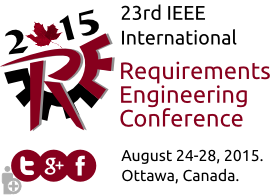A series of tutorials will be held in conjunction with RE'15 to develop skills in and advance awareness of requirements engineering practices. Tutorials will be held before the main conference on August 24-25, 2015.
| Monday, August 24, 2015 | Flyer | |
|---|---|---|
| T01 | Boosting requirements analysis and validation skills through feedback-enabled semantic prototyping (Full-day) | A4 | US Letter |
| T02 | Eliciting Unstated Requirements (or Be Careful What You Ask Users) (Full-day) | |
| T03 | How to Combine Requirements and Interaction Design (Full-day) | |
| T04 | Introduction to Grounded Theory, Measurement and Applications (Full-day) | |
| T05 | Secure Systems Requirements and Construction with Security Patterns (Full-day) | |
| T06 | Writing Good Requirements (Full-day) |
| Tuesday, August 25, 2015 | Flyer | |
|---|---|---|
| T07 | 21 More Powerful Ways to Catch Inadequate Requirements Early (Full-day) | |
| T08 | Aligning Product Line Strategy, Requirements and Features (Half-day - Afternoon) | A4 | US Letter |
| T09 | Business and Software Ecosystems: How to model, analyze, and survive! (Half-day - Morning) | A4 | US Letter |
| T10 | Business Process Compliance Analysis: A Graphical Representation with Tool Support (Full-day) | |
| T11 | Distributed Systems Development using Info Cases (Half-day - Afternoon) | A4 | US Letter |
| T12 | Leverage BABOK® Guide v3 to Deliver Better Business Outcomes (Full-day) | |
| T13 | Writing better requirements with EARS+ (Full-day) |
T01 - Boosting requirements analysis and validation skills through feedback-enabled semantic prototyping
Learning requirements analysis and validation is very hard. Experienced requirements engineers and business analysts manage to mentally picture (i.e. simulate) the future information system in their mind while analyzing and validation requirements. This skill is very hard to achieve by junior requirements engineers. Not surprisingly, computer-based simulation has been proven to be an excellent technique in assisting juniors in understanding complex systems. This tutorial presents a novel, award winning and scientifically proven method that boosts the learning achievements in requirements analysis and validation.
We achieve this by means of feedback-enabled rapid prototyping that allows:
- visualizing solution-oriented requirements which enables semantic conformance checking with domain experts by serving as a simulation instrument to communicate scenarios with users in a fast and easy way
- moving the testing of a prospective system into the requirements engineering phase;
- additionally, allowing less experienced analysts detecting own specification errors such as conflicting, wrongly captured or missing requirements, etc.
The tutorial is comprises interactive demos in which participants will be actively involved for hands-on use of the environment. Participants are welcome however not required to bring any devices themselves. The material used for the course will be available to the participants as a free download. All attendees will get a free USB with software, examples and the material used during the tutorial.
Date
Monday, August 24, 2015 (Full-day)Flyer
Dowload the flyer (A4 | US Letter).Presenters
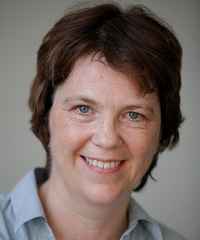
Monique Snoeck
Research Center for Management Informatics, Belgium
Monique Snoeck holds a PhD in computer science from the KU Leuven. She is full professor in the Department of Decision Sciences and Information Management of the Faculty of Economics and Business of the KU Leuven and visiting professor at the University of Namur (UNamur). Her research focuses on requirements engineering, software architecture, model-driven engineering and business process management, conceptual modeling. Her book titled "Enterprise Information Systems Engineering - The MERODE Approach" was published in Springer. Monique Snoeck has presented numerous industrial tutorials in the past through the Belgian organization SAI and at former editions of the TOOLS conferences and the CAiSE conference.

Gayane Sedrakyan
Research Center for Management Informatics, Belgium
Gayane Sedrakyan is a PhD researcher at KU Leuven. She got master degrees in Management Information Systems from KU Leuven, Belgium, 2012 and Computer and Information Science from American University of Armenia, 2007. She received an award in the nomination of "Best master student in Information Technologies (2007)" by the President of Armenia and Synopsys corporation. Gayane has 8 years of programming experience. Her research interests include model driven architecture and engineering, simulation of conceptual models, prototyping-based testing of requirements, process-oriented feedback and feedback automation. Based on MERODE methodology she has been developing a feedback-enabled semantic prototyper to facilitate the process of requirements analysis and modeling.
T02 - Eliciting Unstated Requirements (or Be Careful What You Ask Users)
Have you ever worked on a software project that didn't result in what the users ultimately wanted? Stakeholders, especially end-users, often have requirements in mind that they aren't aware of. Uncovering them can be quite challenging and involves a way of thinking not found in more traditional elicitation approaches. It requires probing interviews and expanded use of context information to break through the confines of what the requirements engineer typically achieves with a specification-driven process. It requires a method that transforms stakeholders' tacit knowledge into explicit statements so that insightful and innovative requirements can emerge.
The Elicitation of Unstated Requirements at Scale (EURS) research team at the Software Engineering Institute developed and validated a method for determining the unstated needs of the varied stakeholders typical of today’s large, diverse programs (e.g., sociotechnical ecosystems). This method, called "KJ+", is scalable to address the needs of multiple categories of stakeholders; usable by a diverse, non-collocated team of requirements analysts; and results in a more complete set of requirements as the basis for subsequent system design, implementation, and continued sustainment.
The tutorial will include presentation of the traditional KJ method for eliciting unstated user needs, as well as the extensions made to allow KJ to be used in a virtual environment (KJ+). The results of a KJ+ case study conducted in 2014 on a real project, will also be presented.
We will present the 8 KJ+ steps, enhanced by the case study that we have completed:
- Step 1: Evaluate existing knowledge of stated needs and requirements
- Step 2: Design the open-ended, probing questions to be used in KJ interviews
- Step 3: Conduct KJ interviews collecting all possible context information
- Step 4: Analyze raw output of interviews to form context need / activity statements
- Step 5: Conduct the KJ Workshop including specialized affinity exercise
- Step 6: Identify Unstated Needs and subsequent Innovative Requirements
- Step 7: Conduct Kano analysis to determine must-be's vs satisfiers vs delighters
- Step 8: Determine quality and performance measures of delighters
- A role-play to elicit unstated needs and their context.
- An exercise to identify affinity groups for the statements
- An exercise to finalize the affinity groups
- An exercise to categorize the unstated needs as must-be's, satisfiers, or delighters
Date
Monday, August 24, 2015 (Full-day)Presenters

Robert Stoddard
Software Engineering Institute, Carnegie Mellon University, USA
Robert Stoddard is a Principal Researcher with the Software Engineering Institute (SEI) at Carnegie Mellon University (CMU) and a primary contributor to the SEI research into eliciting unstated needs and requirements based on previous application of similar methods within several large corporate Design-for-Six-Sigma and Marketing-for-Six-Sigma initiatives. Robert's 10 years with the SEI were preceded by 24 years industry practice with Motorola and Texas Instruments, with experiences as Director of Quality, Software Reliability Manager, Distinguished Member of Technical Staff and Motorola-certified Six Sigma Master Black Belt. Robert holds a variety of American Society for Quality certifications (CQE, CSQE, CRE, CSSBB and CQA) and has authored several books on Six Sigma and Software Reliability. Robert remains active as a Senior Member of both the IEEE and the ASQ, including society committees focused on the Voice of the Customer.

Nancy Mead
Software Engineering Institute, Carnegie Mellon University, USA
Nancy Mead is a Fellow and Principal Researcher at the Software Engineering Institute (SEI). Mead is also an Adjunct Professor of Software Engineering at Carnegie Mellon University. She is currently involved in the study of security requirements engineering and the development of software assurance curricula.
Mead has more than 150 publications and invited presentations, and has a biographical citation in Who's Who in America. She is a Fellow of the Institute of Electrical and Electronic Engineers, Inc. (IEEE) and a Distinguished Member of the Association for Computing Machinery (ACM). She has received the IEEE CS TCSE 2015 Software Engineering Distinguished Education Award. Dr. Mead received her PhD in mathematics from the Polytechnic Institute of New York, and received a BA and an MS in mathematics from New York University.
T03 - How to Combine Requirements and Interaction Design
When the requirements and the interaction design of a system are separated, they will most likely not fit together, and the resulting system will be less than optimal. Even if all the real needs are covered in the requirements and also implemented, errors may be induced by human-computer interaction through a bad interaction design and its resulting user interface. Such a system may even not be used at all. Alternatively, a great user interface of a system with features that are not required will not be very useful as well.
This tutorial explains joint modeling of (communicative) interaction design and requirements (scenarios and use cases), through a Discourse-based Communication Model consisting of a Discourse Model, a Domain-of-Discourse Model and an Action-notification Model. While these models were originally devised for capturing interaction design only, it turned out that they can be also viewed as precisely and comprehensively specifying classes of scenarios, i.e., use cases. In this sense, they can also be utilized for specifying requirements. User interfaces for these software systems can be generated semi-automatically from such models. So, interaction design facilitates requirements engineering to make applications both more useful and usable.
Many software systems are used now in practice by end-users through the Web using multiple devices. So, they have to conform to requirements and to provide appropriate user interfaces tailored for the device used. The tool-supported approach to be presented in this proposed tutorial is unique in combining these two important aspects.
This tutorial is targeted towards people who are supposed to work on the requirements or the interaction design, e.g., requirements engineers, interaction designers, user interface developers, or project managers. It will be of interest for teachers and students as well.
Date
Monday, August 24, 2015 (Full-day)Presenter

Dr. Hermann Kaindl, Professor
Vienna University of Technology, Austria
Hermann Kaindl is full professor, the director of the Institute of Computer Technology and a member of the senate at the Vienna University of Technology. Prior to moving to academia in early 2003, he has gained nearly 25 years of industrial experience in requirements and software engineering as well as human-computer interaction at Siemens Austria. Kaindl is a Senior Member of the IEEE and a Distinguished Scientist Member of the ACM.
T04 - Introduction to Grounded Theory, Measurement and Applications
This full-day tutorial will introduce participants to Grounded Theory, which is a qualitative framework to discover new theory from an empirical analysis of data. This form of analysis is particularly useful when analyzing text, audio or video artifacts that lack structure, but contain rich descriptions. We will frame Grounded Theory in the context of qualitative methods and case studies, which complement quantitative methods, such as controlled experiments and simulations. We will contrast the approaches developed by Glaser and Strauss, and introduce coding theory - the most prominent qualitative method for performing analysis to discover Grounded Theory. Topics include coding frames, first- and second-cycle coding, memoing, and saturation.
In addition, participants will practice: developing a coding frame, coding a source document to discover relationships in the data, developing heuristics to resolve ambiguities between codes, and performing second-cycle coding to discover relationships within categories. This part of the tutorial will focus on how to discover theory from coded data. Participants will further learn about inter-rater reliability statistics, including Cohen's and Fleiss' Kappa, Krippendorf's Alpha, and Vanbelle's Index. They will use these statistics to identify conflicting interpretations in the coded datasets. Finally, we will review how to present Grounded Theory results in publications, including how to describe the methodology, report observations, and describe threats to validity.
Date
Monday, August 24, 2015 (Full-day)Presenters

Travis D. Breaux
Carnegie Mellon University, USA
Travis D. Breaux is an Assistant Professor of Computer Science in the School of Computer Science at Carnegie Mellon University. He received the Ph.D. in Computer Science from North Carolina State University in May of 2009. Dr. Breaux's research includes mixed-methods design, including grounded theory to discover ontologies, formalisms for expressing problems, and cognitive models that explain how humans perform analysis. Dr. Breaux is a 2015 NSF CAREER award recipient for his privacy and security requirements research, and he is a regular member of the IFIP Working Group 2.9 on Requirements Engineering.

Hanan Hibshi
Carnegie Mellon University, USA
Hanan Hibshi is a Ph.D. student in the Societal Computing program at Carnegie Mellon University. Hanan's research area includes: usable security, security requirements and expert's decision-making. Hanan's research involves using grounded theory and mixed-methods user experiments to extract rules for use in intelligent systems. Hanan received her MS in Information Security Technology and Management from the Information Networking Institute at Carnegie Mellon University, and the BS in Computer Science from King Abdul-Aziz University in Jeddah, Saudi Arabia.
T05 - Secure Systems Requirements and Construction with Security Patterns
Patterns combine experience and good practices to develop basic models that can be used to build new systems and to evaluate existing systems. Security patterns join the extensive knowledge accumulated about security with the structure provided by patterns to provide guidelines for secure system requirements, design, and evaluation. We consider the structure and purpose of security patterns, show a variety of security patterns, and illustrate their use in the construction of secure systems. These patterns include among others Authentication, Authorization/Access Control, Firewalls, Secure Broker, Web Services Security, and Cloud Security. We have built a catalog of over 100 security patterns. We introduce Abstract Security patterns (ASPs) which are used in the requirements and analysis stages. We complement these patterns with misuse patterns, which describe how an attack is performed from the point of view of the attacker and how it can be stopped. We integrate patterns in the form of security reference architectures. We introduce patterns in a conceptual way, relating them to their purposes and to the functional parts of the architecture. Example architectures include a financial system and a cloud computing system. The use of patterns can provide a holistic view of security, which is a fundamental principle to build secure systems. The patterns and reference architectures are shown using UML models and examples are taken from my two books on security patterns as well as from my recent publications. The patterns are put in context; that is, we do not present a disjoint collection of patterns but we present a logical architectural structuring where the patterns are added where needed. In fact, we present a complete methodology to apply the patterns along the system lifecycle.
For this conference we emphasize the early lifecycle stages but also show the effect of the requirements in the later stages.
Date
Monday, August 24, 2015 (Full-day)Presenter
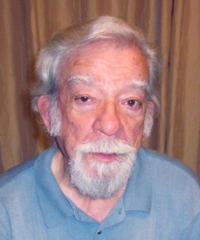
Prof. Eduardo B. Fernandez, Ph.D.
Florida Atlantic University, USA
Eduardo B. Fernandez (Eduardo Fernandez-Buglioni) is a professor in the Department of Computer Science and Engineering at Florida Atlantic University in Boca Raton, Florida, USA He has published numerous papers on authorization models, object-oriented analysis and design, and security patterns. He has written four books on these subjects, the most recent being a book on security patterns. He has created and taught several graduate and undergraduate courses and industrial tutorials. His current interests include security patterns, cloud computing security, and software architecture. He holds a MS degree in Electrical Engineering from Purdue University and a Ph.D. in Computer Science from UCLA. He is a Senior Member of the IEEE, and a Member of ACM. He is an active consultant for industry, including assignments with IBM, Allied Signal, Motorola, Panasonic, Lucent, Huawei, and others.
T06 - Writing Good Requirements
Poor requirements practices are widely recognized as one of the top causes of product defects, project delays, and cost overruns. Yet, a practical solution that balances effective results with the everyday pressures of product development can be hard to find. Teams struggle with questions such as "How much detail is enough?", "What is the difference between requirements and design", and "What requirements practices are right for my project?"
Writing Good Requirements is based on a popular and successful course taught to thousands of students at Intel. It covers effective best practices for specifying requirements that work even for complex, market-driven products. The techniques presented are scalable and have been employed on projects within both agile and traditional methodologies. Rather than presenting a rigid methodology or process, the emphasis is on best practices that can be tailored to a variety of product and project types.
The tutorial contains examples from actual requirements documents in original and improved formats. Small-group exercises and discussions reinforce the content and techniques through the day.
Date
Monday, August 24, 2015 (Full-day)Presenter

John Terzakis
Intel, USA
John Terzakis is a Systems Engineer for the Intel Platform Engineering Group (PEG). He is focused on the requirements for Intel's next generation modem products. His involvement with requirements engineering practices and processes spans the last thirteen years and includes teaching over one hundred requirements classes during that period. He has presented tutorials at the Better Software, ICCGI, Project Summit/BA World and ICSE conferences. He is a Fellow with the International Academy, Research, and Industry Association (IARIA). John holds an MS EE from Stanford University and a BS EE from Northeastern University.
T07 - 21 More Powerful Ways to Catch Inadequate Requirements Early
Most requirements attention is directed toward discovery and documenting. Too often, though, that initial requirements definition contains errors that could be caught but instead slip through, causing expensive and embarrassing downstream difficulties. Most organizations either don't review their requirements at all or typically rely on one or two review methods, mistakenly assuming their reviews have caught all the requirements issues and not having a clue how weak their reviews actually are.
This interactive session introduces 21 methods, including many which are much more powerful, to evaluate adequacy of requirements which already have been defined - that they are accurate, clear, and complete. Following the CAT-Scan Approach™, participants apply each techniques successively to a real case and discover how each different method reveals additional, otherwise-overlooked requirements defects when they are easiest and least expensive to fix. Although presented from a review perspective, the methods once learned also could be applied to help discovery.
Date
Tuesday, August 25, 2015 (Full-day)Presenter

Robin F. Goldsmith
Go Pro Management, Inc., USA
Robin F. Goldsmith, JD is author of the Proactive Testing, Beyond the Textbook Software Acquisition, and REAL ROI methodologies, numerous articles and featured presentations, and the Artech House book, Discovering REAL Business Requirements for Software Project Success.
A subject expert on requirements and testing for TechTarget's SearchSoftwareQuality.com and a subject expert and reviewer for the IIBA Business Analysis Body of Knowledge (BABOK® v2), he works directly with and trains business and systems professionals in requirements analysis, quality and testing, software acquisition, project management and leadership, metrics, ROI, and process improvement.
T08 - Aligning Product Line Strategy, Requirements and Features
Successful software product line organizations evolve to respond to a wide variety of customer, sociological, cultural, technological, economic, political, and environmental changes. They do this by ensuring their business strategy continually addresses customers' requirements and ensuring these requirements are realized by features developed through an engineering strategy that is aligned with the business strategy. Without careful management over time, if the business strategy and engineering strategy are misaligned a product line approach becomes far less effective. This tutorial will use a business-engineering strategy alignment framework to explore and discuss some key issues for effective product line management. At the end of this tutorial participants will be able to:
- Present an overview of product line business and engineering strategies and how strategy affects the deployment and implementation of a range of requirement and feature variability management techniques
- Recognise and explain requirement and feature distinctiveness from customer and supplier perspectives
- Set out a feature development decision framework to aid decisions to make, buy or reuse features
- Describe how planned and unplanned organizational factors can affect business-engineering strategy alignment.
Date
Tuesday, August 25, 2015 (Half-day - Afternoon)Flyer
Dowload the flyer (A4 | US Letter).Presenters

Mike Mannion
Glasgow Caledonian University, United Kingdom
Professor Mike Mannion is Vice-Principal (Research) and Professor of Computing at Glasgow Caledonian University, Glasgow, Scotland, UK. He has several years' software engineering industrial experience and his research interests include product-line engineering, software engineering and engineering education. He is a Chartered Engineer, a Charted Information Practitioner and a member of the British Computer Society, IEEE and ACM. He has published more than 50 papers and run more than 20 tutorials.

Juha Savolainen
Danfoss Power Electronics A/S, Denmark
Dr. Juha Savolainen is Software Director at Danfoss Power Electronics. He has extensive experience in working closely with numerous product lines in helping them to manage and realize variability. His main research interests include requirements engineering, software architectures and product line development. He has published more than 50 papers.
T09 - Business and Software Ecosystems: How to model, analyze, and survive!
Understanding the social and organizational context of organizations is critical to the success of many systems today. This tutorial focuses on the modeling and analysis of Business and Software ecosystems that represent a community supported by a foundation of interacting organizations and the broader commercial, legal and market context in which software systems operate.
In the tutorial we aim at introducing notions related to the modeling and analysis of general ecosystems for the purpose of performing analysis related to their structure in terms of relationships between the different ecosystems component organizations and, for example, of their robustness to critical events occurring in and outside the ecosystem itself. To reify the general notions, we will also focus on one particular type of ecosystems, namely Open Source Software (OSS) ecosystems and on the particular activity of risk management in OSS ecosystems that has been deeply investigated during the EU FP7 project RISCOSS. To emphasize the organizational and social aspect of the ecosystems, their description will be performed using the i* framework that provides an intentional perspective, focusing on the goals that organizations pursue, the various means that can be used to attain them, and the dependencies that ecosystem actors have on each other in order to collaborate and to co-create value.
During the tutorial the participants will be involved in the modeling and analysis of a small OSS ecosystem and of possible risks impacting on the activity of the ecosystem components also exploiting the risk analysis capabilities of the RISCOSS platform.
Date
Tuesday, August 25, 2015 (Half-day - Morning)Flyer
Dowload the flyer (A4 | US Letter).Presenters

Xavier Franch
Universitat Politècnica de Catalunya (Barcelona Tech), Spain
Xavier Franch is Associate Professor at UPC, Spain. His research interests are in the areas of requirements engineering, open-source software management, software architecture, and service monitoring. He has published >150 refereed papers in world-leading journals and international conferences. He belongs to the Editorial Board of Elsevier IST, IET Software and IJISMD and to the Steering Committee of RE, CAiSE, REFSQ and the iStar and TwinPeaks workshops. He has played different scientific roles in conferences like RE, FSE, ESEM, CAiSE, RCIS, REFSQ and ICCBSS, and belonged to more than 150 program boards and committees. He is member of IREB and ISERN. He is coordinator of the FP7 RISCOSS project and scientific manager of the H2020 SUPERSEDE project.

Angelo Susi
Software Engineering Unit, Italy
Angelo Susi is a research scientist in the Software Engineering group at Fondazione Bruno Kessler in Trento, Italy. His research interests are in the areas of requirements engineering, goal-oriented software engineering, formal methods for requirements validation, and search based software engineering. He published more than 80 refereed papers in journals and international conferences such as TSE, TOSEM, IST, SoSyM,, ER, FSE, ICSE, RE. He participated in the organization committee of several conferences, such as SSBSE '12 (General Chair), RE '11 (Local and Financial chair) and in program committees of international conferences and workshops (such as AAMAS, ICSOC and SSBSE). He also served as reviewer for several Journals such as TSE, REJ, IST, JSS. He is the scientific manager of the EU FP7 project RISCOSS.
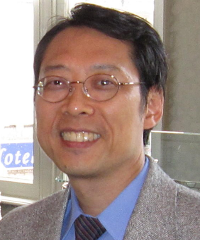
Eric S.K. Yu
University of Toronto, Canada
Eric S. K. Yu is Professor at the University of Toronto, Canada. His research interests are in the areas of information systems modeling and design, requirements engineering, knowledge management, and software engineering. Books he has co-authored or co-edited include: Social Modeling for Requirements Engineering (MIT Press, 2011); Conceptual Modeling: Foundations and Applications (Springer, 2009); and Non-Functional Requirements in Software Engineering (Springer, 2000). He is an associate editor for the Int. Journal of Information Systems Modeling and Design, and serves on the editorial boards of the Int. J. of Agent Oriented Software Engineering, IET Software, and the Journal of Data Semantics. He is co-editor for the MIT Press book series on Information Systems. He was Program Co-chair for the 27th and 33rd Int. Conference on Conceptual Modeling (ER'08, ER'14).
T10 - Business Process Compliance Analysis: A Graphical Representation with Tool Support
In their daily activities, business analysts,requirement engineers and researchers strive to analyze and document their high-level objectives and business needs in terms of goal models and business process models. While doing so, they are on one hand, constrained to preserve legal compliance with the laws, internal regulations, polices, guidelines and on the other hand, compelled to decide between multiple alternatives and motivate the rational behind their decisions.
Structured in multiple parts, this tutorial aims to provide thoughtful insights on business process compliance modeling and analysis, suggest tool support and tackle examples from Enterprise Architecture (EA) modeling. The tutorial will focus on the User Requirements Notation (URN) and its extensions as follows:
URN is a standard modeling notation from ITU-T which combines a goal modeling notation (Goal-oriented Requirements Language (GRL) with a business process modeling notation (Use Case Maps (UCM). URN has the capability to be extended with profiles, such that it is possible to add customized intentional elements and rules for different purposes and application domains into URN. One of the recent extension of URN modeling language is the privacy compliance analysis framework called Legal-URN framework. Legal-URN provides tools and methods for extracting legal requirements in terms of goals and processes and analyzing the compliance in a semi-automatic way. It exploits and extends the URN tool-support, jUCMNav with its legal profile.
We illustrate how URN can be expanded and applied in practice, by applying it to EA modeling. This task is two folded: first, we show how to use URN for formalizing EA principles (underlying general rules, similar to regulations, less strict) and second, we introduce a formal argumentation framework, that allows the user to express the reasoning about goals, beliefs, actions and the links between them.
Our goal is to provide participants a good foundations regarding URN and existing tools, while tackling examples and real-life applications.
Special Notes
Attendees must bring a WiFi-enabled laptop computer to the tutorial.
Date
Tuesday, August 25, 2015 (Full-day)Presenters

Dr. Sepideh Ghanavati
Luxembourg Institute of Science and Technology, Luxembourg / Carnegie Mellon University, USA
Dr. Sepideh Ghanavati is a visiting faculty at the Institute for Software Research at Carnegie Mellon University and postdoctoral researcher at Luxembourg Institute of Science and Technology. Her research focuses on Requirements Engineering, URN, goal modeling notations, business process legal compliance. She is also a contributor to ITU-T, URN standard and one of the many developers of jUCMNav. She also has three years of industry experience where she worked as a Senior Project Manager and Senior Business Analyst.

Diana Marosin
Luxembourg Institute of Science and Technology, the Netherlands
Diana Marosin is currently a PhD candidate Radboud University Nijmegen, the Netherlands, hosted by Luxembourg Institute of Science and Technology. She got her MSc degree in Information and Computer Science from the University of Luxembourg where she focused mainly on adaptive computing and artificial intelligent. Her research interests are enterprise architecture, normative systems and regulatory compliance.

Marc van Ze
University of Luxembourg, Luxembourg
Marc van Zee is currently a PhD student at the University of Luxembourg. He got his MSc in Computer Science (Technical Artificial Intelligence) from the Utrecht University in The Netherlands in February 2013. His research interests are focused particularly on the area of (multi-)agent systems with emphasis on practical applications in this field, and on logic formalisms using nonmonotonic reasoning.
T11 - Distributed Systems Development using Info Cases
This interactive tutorial is addressed to undergraduate and graduate students, as well as researchers and industry practitioners. It is devoted to illustrating how distributed software systems can be developed from their first principles using info cases. Distributed systems are harder to develop than software in other domains, not only due to the hostile environments in which they normally appear, but also due to their additional functional requirements, such as location dependency, concurrency and non-determinism. Despite this complexity, distributed system behaviours depend on rich patterns of information flow, suggesting that info cases are perfectly fitted to support their development. Info cases can be regarded as a specialization of use cases, based on the elicitation of information flows between the system and its external actors, from which domain models can be derived using a structured method based on semi-formal rules. Empirical studies suggest that info cases guide requirements elicitation activities to happen in a more systematic way, while reducing inconsistencies between derived domain models. The tutorial will present all the steps and tools adopted in the development of a complete distributed information system example devoted to automating retail networks, comprising both physical and virtual shops, starting from the construction of an info case model, proceeding with the development of database and user interface functionality and culminating with the system implementation in Java using the Eclipse software development environment. It is expected that, after the tutorial, attendees will be able to replicate the adopted development path in other situations and contexts.
Date
Tuesday, August 25, 2015 (Half-day - Afternoon)Flyer
Dowload the flyer (A4 | US Letter).Presenters
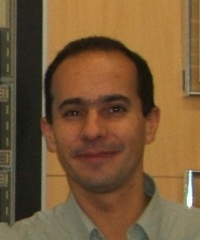
Carlos Henrique Cabral Duarte
Brazilian Development Bank, Brazil
Carlos Henrique Cabral Duarte is a Member of Technical Staff at the National Bank of Social and Economic Development (BNDES, 1992-), Rio de Janeiro, Brazil, where he is currently responsible for the accreditation of machines and equipment, particularly of the healthcare sector (2012-). Previously, he was an operations manager and deputy head of department (2002-12), having financed more than 60 ICT companies, two of which now listed in the Bovespa Stock Market as a direct result of his work. He was the BNDES representative in the National IT Committee and deputy board member of the National Society for the Advancement of Software Quality (2003-12). In 2007, his biography was included in the publication Marquis Who is Who in the World due to his contributions to the Brazilian software industry. Carlos Henrique has also had an academic career. He worked as a Lecturer in some Brazilian Universities (1999-2009) and has written and reviewed papers for scientific journals and conferences, recently becoming also a panelist (in the issues of the Ready-Set-Transfer series, held during RE 2013 and ICSE 2014), workshop organizer (CESI 2015, held in conjunction with ICSE 2015) and an industry committee member (RE 2014-5). Carlos holds PhD (Imperial College, London, 1999), MSc (PUC-Rio, 1994) and BMath (UFJF, 1992) degrees in computing.

Michel Heluey Fortuna
Federal University of Juiz de Fora (UFJF), Brazil
Michel Heluey Fortuna is an Associate Professor at the Computer Science Department of the Federal University of Juiz de Fora, Brazil (1984-). He was a key person leading the creation of the BSc course on Computing in that university (2000). Since then, he wrote a book about systems modeling and has taught, conducted research projects and supervised students therein, as well as occupied management positions in university and course administration. Previously, Michel was a System Analyst at Rede Ferroviária Federal S.A. (1983-1996). He holds PhD (COPPE/UFRJ, 2008) and MSc (IME, 1982) degrees in computing and a BEng (UFJF, 1979) degree. He has been a member of ACM and IEEE, Computer Society.
T12 - Leverage BABOK® Guide v3 to Deliver Better Business Outcomes
BABOK® Guide v3 is the definitive guide and internationally recognized standard for the business analysis profession. Published by the International Institute of Business Analysis (IIBA), it is a comprehensive and essential tool for the practice of business analysis.
The IIBA spearheaded a global effort led by a core team of recognized thought leaders in business analysis and 150 volunteers from 20 countries, representing 15 different industries. It became a true global community effort as BABOK Guide went through 3 public review cycles. Over 4500 comments were received, reviewed and actioned to ensure that the updated version truly represented the global community of business analysis practitioners.
So what's included in the newest version? How does it improve on the prior global standard - BABOK Guide version 2? As a business analysis practitioner, how can I leverage it to execute my project work? As an organization how can we harness the power of BABOK v3 to deliver better business outcomes?
Come to this tutorial to discuss these questions and many more! It was published this year in April so here's your opportunity to become one of the first to understand the value that v3 can deliver to your organization and to your daily work.
Date
Tuesday, August 25, 2015 (Full-day)Presenter

Jas Phul
International Institute of Business Analysis
Jas is a seasoned professional whose career has spanned over 25 years of helping project teams and organizations reach their potential. As a Certified Business Analysis Professional® (CBAP®), a Project Management Professional® (PMP®), a Certified Agile Project Manager (Cert. APM®), and a Certified Change Management Expert (Prosci®), Jas leverages a unique combination of knowledge, skills and experience for each challenge.
During his career, Jas has experienced a wide variety of industries as a Business Analyst, Project Manager, Technical Specialist, IT Software Development Manager, and Senior Management Consultant. He provides deep expertise in helping organizations leverage and integrate best practices across multiple disciplines to dramatically improve organization performance.
In his role of Product Manager - BA Practice Development at IIBA® (International Institute of Business Analysis), Jas serves a global community of business analysis professionals, providing innovative products and services that can be leveraged at an organizational level to drive better business outcomes.
T13 - Writing better requirements with EARS+
Easy Approach to Requirements Syntax (EARS) has been shown to drastically reduce or even eliminate the main problems typically associated with natural language (NL) requirements and is widely used in academia and in a range of industries. The enhanced EARS+ notation allows requirements authors to add more detail where necessary, whilst maintaining the readability of textual requirements.
Black box system requirements are usually written in unconstrained NL, which is inherently imprecise. During system development, problems in system requirements often propagate to lower levels. This creates unnecessary volatility and risk, which impact programme schedule and cost. To mitigate this problem, there is a need to provide simple, practical guidance for authors of NL requirements. EARS is a notation for authoring NL requirements through the application of a template with an underlying ruleset. EARS has proved popular with practitioners because it is lightweight, there is little training overhead, no specialist tool is required and the resultant requirements are easy to read.
In practice, requirements authoring is usually an iterative process; first-pass requirements can be quite a simple description of required system behaviour, whilst subsequent iterations are used to add detail. Simple EARS is an effective mechanism for the expression of simple requirements, but does not adequately define precise, rigorous requirements. To address these shortcomings, the enhanced EARS+ template has been developed. EARS+ provides a mechanism to vary the level of detail in NL requirements during iterative requirements authoring. The requirement author can add clauses such as stakeholder, action and object, which have defined syntax. This produces a precise description of the required system behaviour. The practitioner can choose which clauses to apply, thereby tailoring each requirement to the appropriate level of detail, whilst maintaining the readability of NL.
This interactive tutorial will introduce the EARS+ approach, illustrate worked examples of both simple and detailed requirements and discuss the benefits of adopting the approach. The afternoon session will allow participants to work on real requirements from their own projects, with support. Participants will leave with a working knowledge of EARS+, having already applied it to their own requirements.
Date
Tuesday, August 25, 2015 (Full-day)Presenters

Alistair Mavin
Rolls-Royce PLC, United Kingdom
Alistair Mavin (Mav) is a requirements specialist at Rolls-Royce PLC based in Derby, UK and has carried out systems engineering and requirements engineering projects in a range of industries including defence, aerospace, rail and automotive. He is the lead author of the EARS+ notation and has experience in the development and delivery of requirements engineering training and in innovation and creativity support. Mav has published many papers on requirements and systems engineering, was Industry Chair for RE13 and Industry Laboratory Chair for RE14, is a member of the "RE" conference series Industry Committee, a member of the British Computer Society's (BCS) Requirements Engineering Specialist Group (RESG) committee and is a chartered engineer.

Eero Uusitalo
IntoWorks Oy, Finland
Eero Uusitalo is co-founder and consultant at IntoWorks Oy, a company dedicated to tackling the challenges of designing and building complex safety-critical systems while maintaining and demonstrating regulatory and standards compliance. Eero has previously researched requirements engineering at the Aalto University in Helsinki and worked as an I&C inspector at the Finnish Radiation and Nuclear Safety Authority.
